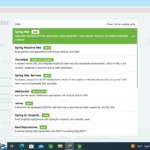Mastering Excel Efficiency: 100 Essential Shortcuts for Maximum Productivity
Introduction:
Excel is a powerful spreadsheet software that is used by millions of professionals for data analysis, calculation, and organization. To truly unleash its potential, it is crucial to master keyboard shortcuts. Excel shortcuts can significantly enhance your productivity, save time, and streamline your workflow. In this comprehensive article, we will delve into 100 Excel shortcuts that every user should know to become an Excel power user.
why learning Excel is essential and the advantages it offers ?
- Data Organization and Analysis:
Excel provides a structured and organized platform to store, manage, and analyze data. It allows you to create spreadsheets with rows, columns, and cells to input and manipulate data in a systematic manner. With Excel, you can sort, filter, and format data, perform calculations, create charts and graphs, and generate reports, making it an indispensable tool for data organization and analysis. - Increased Efficiency and Productivity:
By learning Excel and utilizing its powerful features and functions, you can automate repetitive tasks, streamline workflows, and save valuable time. Excel offers a wide range of tools such as formulas, functions, macros, and pivot tables that can automate complex calculations, data manipulation, and reporting. With Excel’s ability to handle large datasets and perform calculations at lightning speed, you can accomplish tasks that would otherwise be time-consuming and error-prone. - Financial Management and Analysis:
Excel is extensively used in finance and accounting for tasks such as budgeting, financial modeling, forecasting, and data analysis. It allows professionals to create complex financial models, perform calculations like net present value (NPV) and internal rate of return (IRR), track expenses, and generate financial reports. Excel’s ability to handle financial data with precision and accuracy makes it an indispensable tool for financial professionals. - Project Management and Planning:
Excel is widely used in project management for tasks such as creating Gantt charts, tracking project timelines, managing resources, and analyzing project data. With Excel, you can create dynamic project schedules, track progress, allocate resources, and analyze project performance. Its flexibility and versatility make it a valuable tool for project managers to effectively plan, monitor, and control projects. - Data Visualization:
Excel offers a wide range of visualization tools, such as charts, graphs, and dashboards, to represent data visually. Visualizing data in Excel helps in better understanding and communicating insights and trends. With Excel’s intuitive charting capabilities, you can create visually appealing charts and graphs that make complex data more accessible and understandable for stakeholders. - Collaboration and Sharing:
Excel allows for seamless collaboration and sharing of spreadsheets with colleagues and team members. Multiple users can work on the same workbook simultaneously, making it easy to collaborate on data analysis, reporting, and decision-making. Excel also enables data sharing through various formats, including exporting to PDF, sharing via email, or integrating with other Microsoft Office applications. - Career Advancement:
Proficiency in Excel is highly valued by employers across industries. Whether you are seeking a new job or aiming for a promotion within your organization, having strong Excel skills can significantly boost your resume and set you apart from the competition. Many job postings explicitly mention Excel proficiency as a required or preferred skill. Being proficient in Excel opens up a wide range of career opportunities and increases your employability in today’s data-driven job market.
Learning Excel is a valuable investment that offers numerous advantages for professionals in various fields. From data organization and analysis to increased efficiency, financial management, project management, data visualization, collaboration, and career advancement, Excel provides a powerful set of tools to enhance productivity, streamline workflows, and drive data-driven decision-making. Whether you are a beginner or an experienced user, continuously improving your Excel skills can unlock
new opportunities and empower you to excel in your professional endeavors.
Navigating and Selecting:
- Ctrl + A: Select the entire worksheet.
- Ctrl + Shift + →: Select the entire row of the active cell.
- Ctrl + Shift + ↓: Select the entire column of the active cell.
- Ctrl + Spacebar: Select the current column.
- Shift + Spacebar: Select the current row.
- Ctrl + Shift + Spacebar: Select the entire worksheet.
- Ctrl + Shift + * (asterisk): Select the current region around the active cell.
- Ctrl + . (period): Move to the next corner of a selected range.
- Ctrl + ← (left arrow): Move to the leftmost cell in the current row.
- Ctrl + ↑ (up arrow): Move to the topmost cell in the current column.
- Ctrl + ↓ (down arrow): Move to the bottommost cell in the current column.
- Ctrl + Page Up: Switch to the previous worksheet.
- Ctrl + Page Down: Switch to the next worksheet.
- Ctrl + Home: Move to cell A1.
- Ctrl + End: Move to the last cell of the worksheet.
- F5: Go To dialog box – jump to a specific cell, range, or named range.
Editing and Formatting:
- F2: Edit the active cell.
- Ctrl + X: Cut the selected cells or range.
- Ctrl + C: Copy the selected cells or range.
- Ctrl + V: Paste the cut or copied cells or range.
- Ctrl + Z: Undo the last action.
- Ctrl + Y: Redo the last action.
- Ctrl + F: Open the Find and Replace dialog box.
- Ctrl + H: Open the Find and Replace dialog box for search and replace.
- Ctrl + B: Apply bold formatting.
- Ctrl + I: Apply italic formatting.
- Ctrl + U: Apply underline formatting.
- Ctrl + Shift + F: Apply the font drop-down list.
- Ctrl + Shift + P: Apply the point size drop-down list.
- Ctrl + Shift + >: Increase font size.
- Ctrl + Shift + <: Decrease font size.
- Ctrl + 1: Open the Format Cells dialog box.
- Ctrl + 5: Apply or remove strikethrough formatting.
- Ctrl + 9: Hide the selected rows.
- Ctrl + Shift + 9: Unhide any hidden rows within the selection.
- Ctrl + 0: Hide the selected columns.
- Ctrl + Shift + 0: Unhide any hidden columns within the selection.
- **Ctrl + Shift + &: Apply the outline border to the selected cells.
- **Ctrl + Shift + _: Remove the outline border from the selected cells.
- Ctrl + Shift + ~: Apply the General number format.
- Ctrl + Shift + $: Apply the Currency number format.
- Ctrl + Shift + %: Apply the Percentage number format.
- **
Ctrl + Shift + ^**: Apply the Scientific number format.
- Ctrl + Shift + #: Apply the Date number format.
- Ctrl + Shift + @: Apply the Time number format.
Formula and Calculation:
- F4: Repeat the last action.
- Ctrl + ` (grave accent): Toggle between displaying cell values and formulas.
- Alt + =: AutoSum the selected range.
- F9: Calculate the active worksheet.
- Shift + F9: Calculate the selected range.
- Ctrl + Shift + Enter: Enter an array formula.
- F11: Insert a new chart sheet.
- Ctrl + : (colon): Enter the current time.
- Ctrl + ; (semicolon): Enter the current date.
Working with Worksheets:
- Ctrl + N: Create a new workbook.
- Ctrl + O: Open an existing workbook.
- Ctrl + S: Save the workbook.
- Ctrl + F12: Open the Save As dialog box.
- Ctrl + W: Close the current workbook.
- Ctrl + F4: Close Excel.
- Ctrl + F7: Open the Move dialog box.
- Ctrl + F8: Resize the Excel window.
- Ctrl + F9: Minimize the workbook window.
- Ctrl + F10: Maximize or restore the workbook window.
- Ctrl + Tab: Switch between open workbooks.
- Ctrl + Shift + Tab: Move to the previous workbook window.
Data Entry and Manipulation:
- Alt + Enter: Start a new line within a cell.
- Ctrl + ‘ (apostrophe): Copy the formula from the cell above.
- Ctrl + ~ (tilde): Display formulas in the worksheet.
- Ctrl + Shift + ” (double quotation marks): Copy the value from the cell above.
- Ctrl + Spacebar: Select the entire column.
- Shift + Spacebar: Select the entire row.
- Ctrl + Shift + Spacebar: Select the entire worksheet.
- Alt + Down Arrow: Display the AutoComplete list.
- Ctrl + D: Fill down the selected cells.
- Ctrl + R: Fill right the selected cells.
- Ctrl + – (hyphen): Delete the selected column or row.
- Ctrl + Shift + + (plus): Insert cells, columns, or rows.
- Ctrl + Shift + – (hyphen): Remove cells, columns, or rows.
- Ctrl + ]: Jump to the precedent cell.
- Ctrl + [: Jump to the dependent cell.
Working with Tables:
- Ctrl + L: Create a table from the selected range.
- Ctrl + Shift + F3: Create a name by using the names of the row and column labels.
- Ctrl + Shift + L: Toggle the AutoFilter on or off.
- Ctrl + Shift + T: Convert a range into a table.
- Ctrl + T: Create a table from the selected range.
- Ctrl + J: Fill data down in a column table.
PivotTables:
- Alt + ↓ (down arrow): Expand or collapse the selected field in a PivotTable.
- Alt + ← (left arrow): Collapse the field group in a PivotTable.
- Alt + → (right arrow): Expand the field group in a PivotTable.
- Alt + Shift + →: Group the selected items in a PivotTable.
- Alt + Shift + ←: Ungroup the selected items in a PivotTable.
Miscellaneous:
- Ctrl + K: Insert a hyperlink.
- Ctrl + P: Print the workbook.
- Ctrl + F2: Open the Print Preview window.
- F1: Open Excel Help.
- Shift + F1: Start the context-sensitive Help or reveal formatting.
- F12: Save As.
- Alt: Display Key Tips on the Ribbon.
- Shift + F10: Display the right-click menu.
Conclusion:
Mastering Excel shortcuts is the key to boosting your productivity and becoming an Excel power user. By using these 100 essential shortcuts, you can navigate, edit, format, calculate, and manipulate data with ease. Practice incorporating these shortcuts into your Excel workflow, and soon you’ll notice significant time savings and increased efficiency.
Happy Learning.



